2004 VOLKSWAGEN GOLF PLUS battery
[x] Cancel search: batteryPage 35 of 541
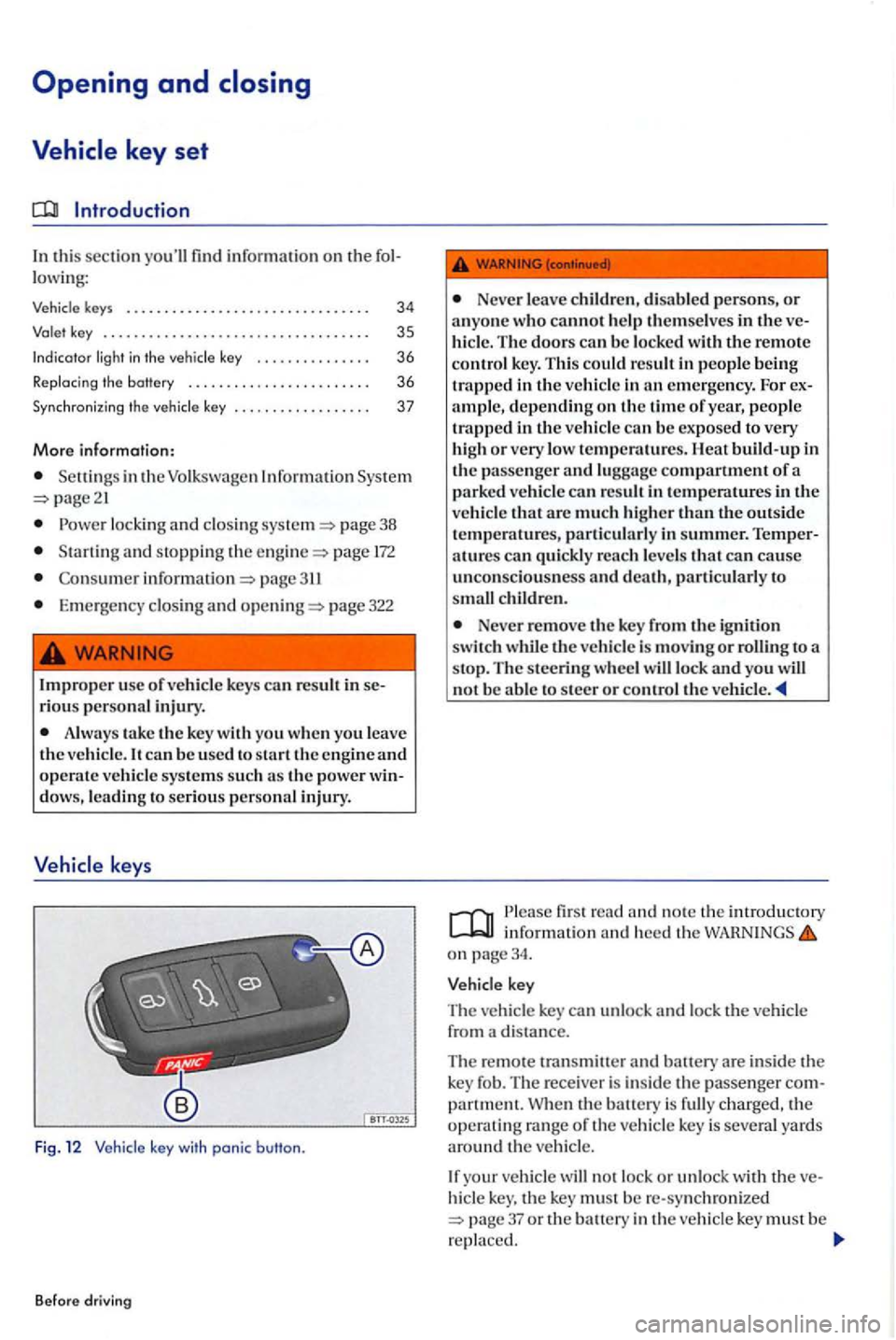
In this sec tion find informa tion on th e
key s . . . . . . . . . . . . . . . . .
. . . 3 5
Indicator
. . . . . . 36
R ep lacing the battery . . . . . . . . . . . . . . . . . . . . 36
Synchronizing the . . . . . . . . . . . 3 7
More information:
Se tting s in the Volk s wa gen In fo rm ation Sys te m page21
p age 38
Start ing a nd stopping the page 172
Co nsumer pag e
Em erge ncy clo sin g and page 322
Imprope r u se of vehi cle keys can r esult in riou s personal injury.
Always tak e th e key with you wh en you lea ve
th e vehicle. It ca n b e use d to start th e e ngine and operate ve hicl e sys te m s s uch as th e po wer
keys
Fig. 1 2 Vehicl e key with panic button.
B efo re drivin g
Neve r leave childr en , di sabl ed p ersons, or a nyo ne wh o cannot help the m se lves in the hicle. The doors ca n b e lo ck ed with the remote
contro l k ey. Thi s could result in pe ople bein g
trapp ed in the ve hicl e in em erg en cy . F or depending on th e tim e of year, p eopl e
trapp ed in the ve hicl e can be ex po sed to very
hi gh or very low temperatures. Heat build -up in
th e passe nger and luggage compartment of a
p a rk ed ve hicle can res ult in temperatures in the
ve hicl e th at are much higher th an th e outside temperatures, part ic ul arl y in summer. atures can qui ckly reac h leve ls that can unco nsciou sn ess and death, particul arl y to c hildr en.
Never remove the key fro m the ig niti on switch th e vehicl e is moving or ro lling to a
s top. The s tee rin g w heel will lock and yo u no t be able to steer o r co ntro l th e veh icle.
fir s t r ead and no te th e in troduc tory in fo rm ation and heed the on page34.
key
The vehicle key can unl ock and lock th e vehicl e
from a di stance.
The remo te tran sm itte r
and batt ery are inside th e
k ey fo b. Th e receiver i s in side the passe nge r
hicle key , th e key mu st b e re-sy nchro ni ze d 37 or the battery in the vehicle key must b e
r epla ced.
Page 36 of 541
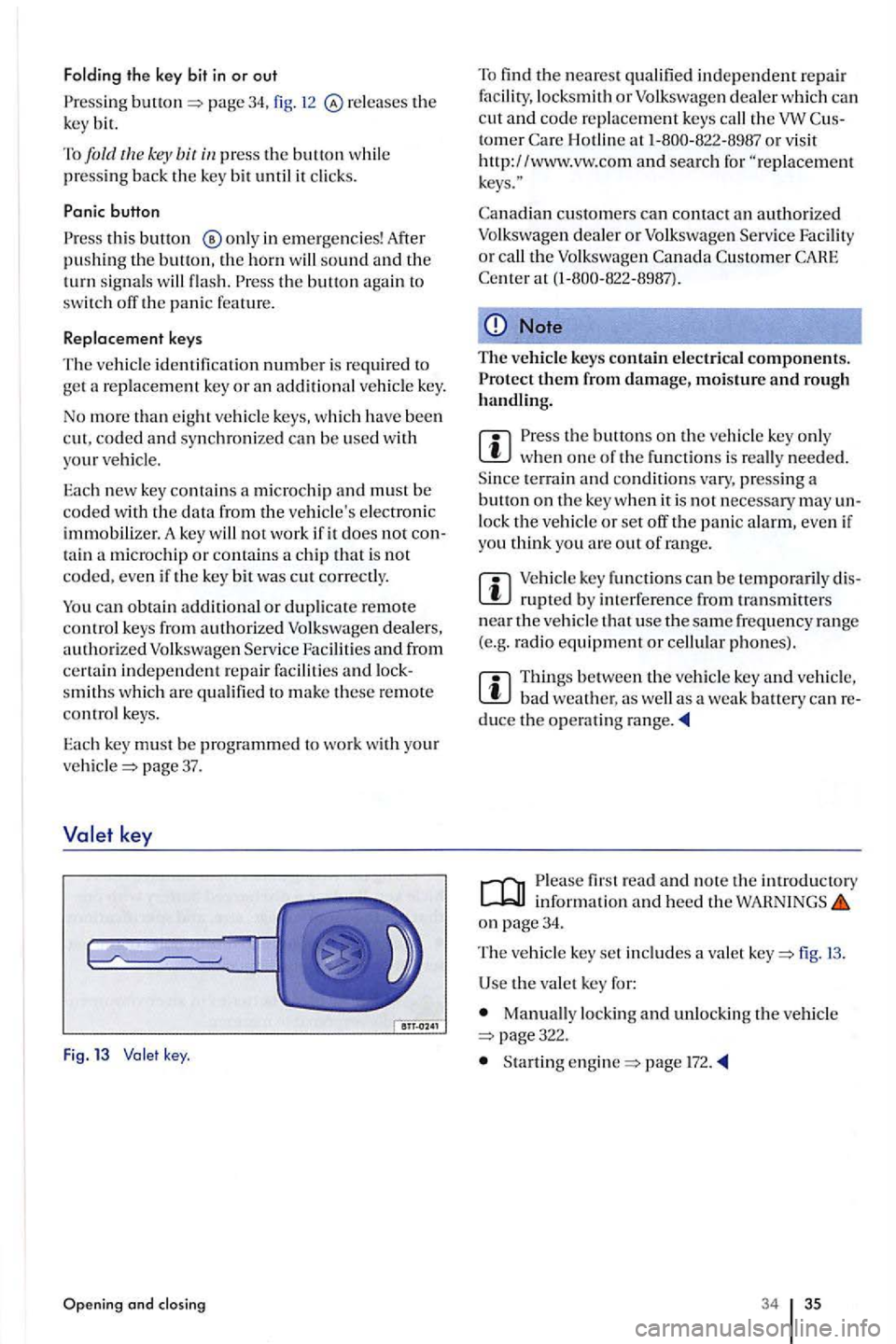
Folding the key bit in or out
Press ing page 34, fig. releases the
k ey bit.
To
fold th e key bit
this button in emergencies! After pushin g th e button, the horn will sound and the turn signal s will the button aga in to
sw itch off the panic fe ature.
Replacement keys
The ve hicl e id entifi cation number is required to
ge t a replacement k ey or an additiona l vehicle key.
No more th an eight ve hicl e keys , w hi ch have been
cut. coded and syn chroni zed can be used with your ve hicle .
E a c h n
ew key contains a microchip and must be coded w ith the data from the ve hicle's electroni c immobilizer. A key will not work if it does not co n
t a in a mi crochip o r co ntains a chip that is not coded, even if the key bit was cut co rrectly.
You can obtain additional or duplicate remote co ntrol keys from authorize d Volkswagen dealers,
authorize d Volkswage n Service Facilities and from certain indep end ent repai r facilities and locksmiths which are qualifi ed to make these remote control keys.
Eac h key must be programmed to wo rk with your pag e 37.
key
Fig . 13 key .
Opening and closing
To find the nearest qualifi ed ind ep endent repair fac ility, locksmith or Volkswag en d eal er w hi ch ca n
c ut and co de re placement keys call the tomer H otlin e at
cu stomers can contact an authorized Volkswagen dea ler or Volksw age n Serv ice Facility or call the Volk swage n
Note
The vehicle keys contain electrica l components.
the buttons on the ve hicl e key onl y when one of th e fun ctions is re all y needed .
S ince terrain and condition s vary , pressing a button on the key whe n it is not ne cess ary may un
l ock the vehicle or set off the panic alarm, eve n if
yo u think yo u are out of rang e.
m key fun ctions can be te mporaril y dis
bad weather. as well as a weak battery can reduce the operating range.
fir st read and note the introductory information and heed the WAHNINGS on page 34.
The ve hicl e key set includes a valet fig.
U se the va le t key for:
Manually locking and unlock ing the v ehicle page322.
Startin g page l72.
34 35
Page 37 of 541
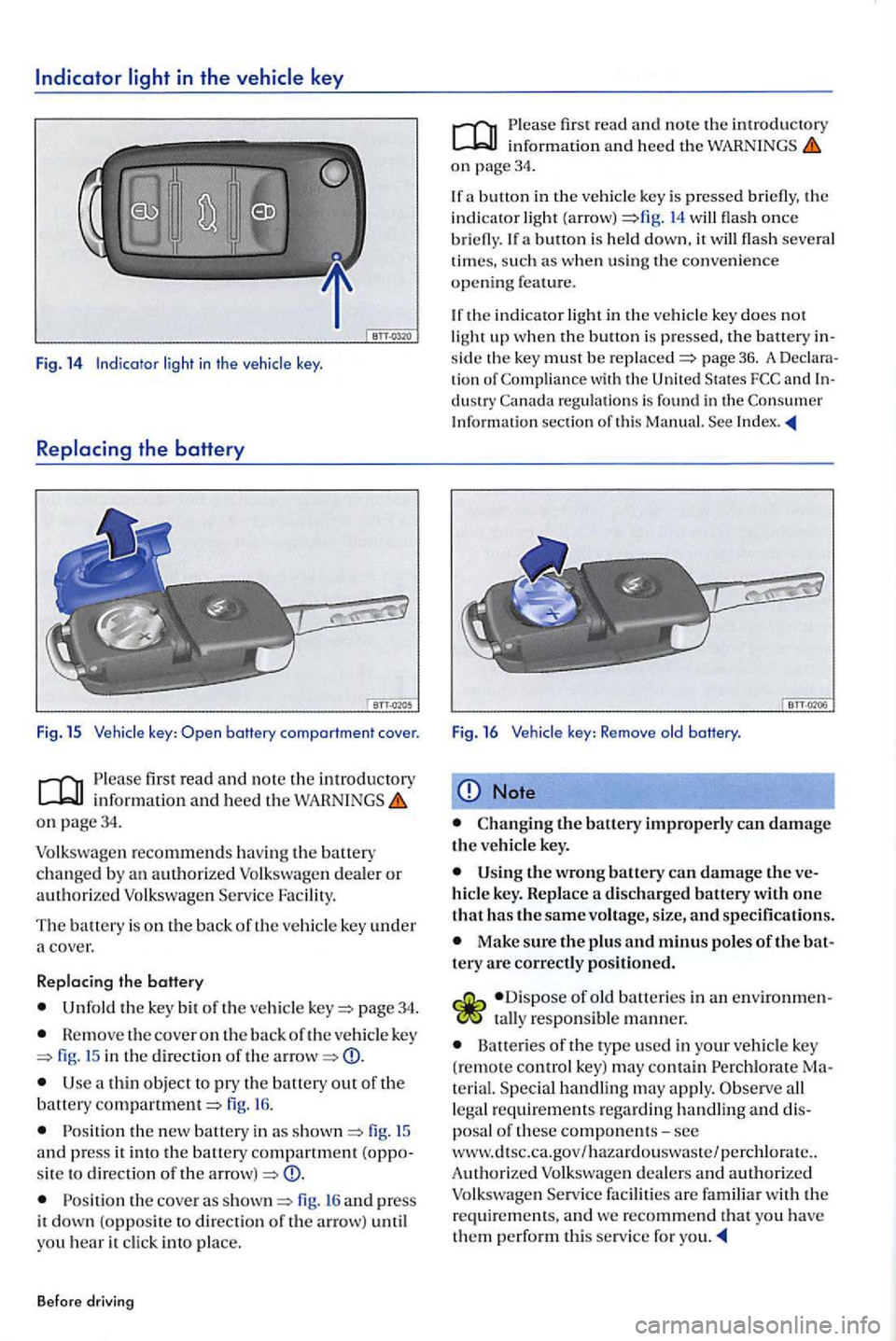
light in the vehicle key
Fig. 14 Indicator in th e
key: battery comportment cover.
first read and note the introductory information and heed the on page34.
page 34.
Remove the cover on the back of the veh icle key fig. in the direct io n of the CD.
a thin object pry th e battery out of the battery fig. 16.
fig . an d press it into the battery compartment sit e to direction of the CD.
th e cove r as fig. 16 and press
it down (opposit e to direction of the arr ow) until
yo u hear it click into place.
Before driving
first read and note the introductory information and heed the on page 34.
a button i n the (a rrow) flash once briefly. a button is down, it flash severa l
tim es. such as when using the convenience open ing feature.
key does not up when the button is p ressed, the battery the key must be page 36. A tion of
Note
Changing the battery improperly can damage the veh icle key.
th e battery can damage the hicl e key. Replace a discharged battery with one
t hat has the same voltag e, siz e, and specifications.
Make sure the plus and minus poles of the tery are correctly positioned.
responsib le man ner.
Batteries of the typ e used in your vehicle key
(remote control key) may contain Specia l handling may apply. legal requirements regard ing
dea lers and authorized
Page 39 of 541
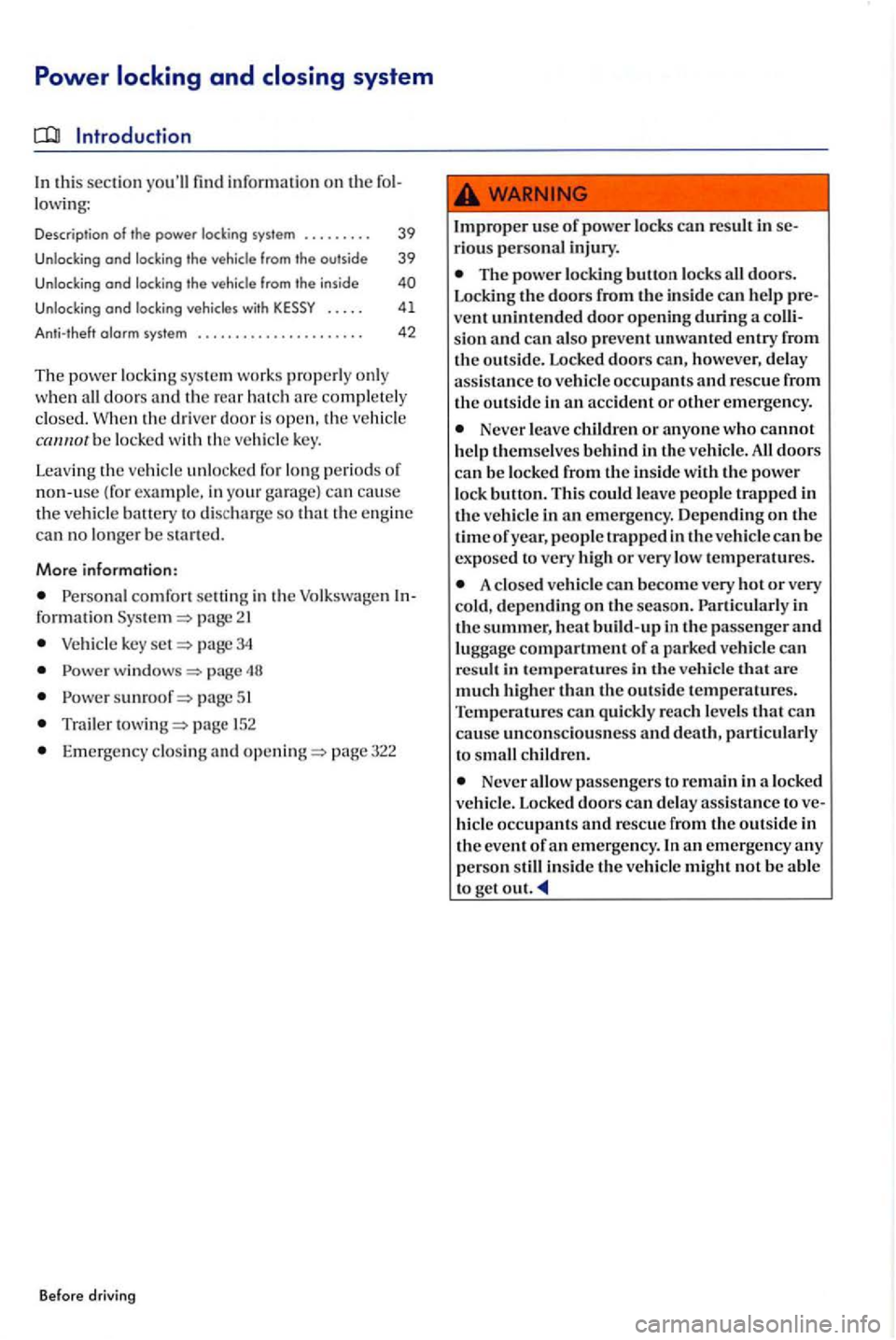
Power
Introducti on
In t his section you'll fin d information on th e fol
low ing:
Descr ip tio n of the power system . . . . . . . . . 39
Unlocking and locking the veh icle from outside 39
Unlocking and locking the vehicle from the inside
. . . . . 41
alarm system . . . . . . . . . . . . . . . . . . . . . . 42
The powe r locki ng sys te m works properly on ly
w he n all doors and t he rear ha tc h co mpl ete ly
cl osed. When th e driver door is open, th e vehicle b e locke d with the vehicle key.
Leavi ng the vehi cle unlocke d for long perio ds of
no n-use (for examp le, in your garage) can ca use th e veh icle battery to discharge so that the engine
ca n n o longer be sta rt ed.
More information:
Pe rsonal comfort settin g in t he Volkswagen Informatio n pag e 21
Vehicle key page 34
Powe r page
Power page 51
Trailer p age 152
Eme rge ncy clos ing a nd pag e 322
Before drivi ng
Improper use of powe r locks can res ult in se
r io us perso nal inju ry.
Th e powe r locki ng button locks all doo rs.
Lockin g th e doo rs f ro m the insid e ca n h elp pre
ven t unintended d oor o penin g during a colli
s io n and ca n also prevent un wa nted entry from th e outsid e. Lock ed d oors ca n, however, d e lay
a ss istance to vehicl e occupant s and resc ue from
th e outsid e in an accid ent or o ther em erge ncy .
Neve r le a ve childr en or an yone who cannot help themselves behind in the ve hicl e. All do ors
can be lo ck ed fro m th e in side w ith the power
l oc k button. T his co uld leave people trapped in ve hicl e in an em erge ncy. Dep endin g on the
tim e of peopl e trappe d in the ve hicl e ca n b e
ex po sed t o very high or very lo w t emperatures.
A close d ve hicl e ca n beco me very hot or very d ep ending on the seaso n. Particularly i n
th e summer, heat build -up in lh e passe nge r and lu ggage compartment of a parked ve hicl e ca n
res ult in temperatures in the ve hicle that are much hi gher tha n th e o utside temperatures .
T e mperatures can quickly reac h leve ls that can cause unconsci ousn ess and deatJ1, parti cularly
t o s mall childr en .
Neve r all ow passe nge rs to re main in a lo ck e d
ve hicl e. Locked doors ca n delay ass is ta nce to ve
hicle occupants and r esc ue f ro m the o ut side in
th e event of an emerge ncy. In an em erge ncy an y perso n still insid e th e vehicle might no t b e a ble
t o ge t
Page 43 of 541
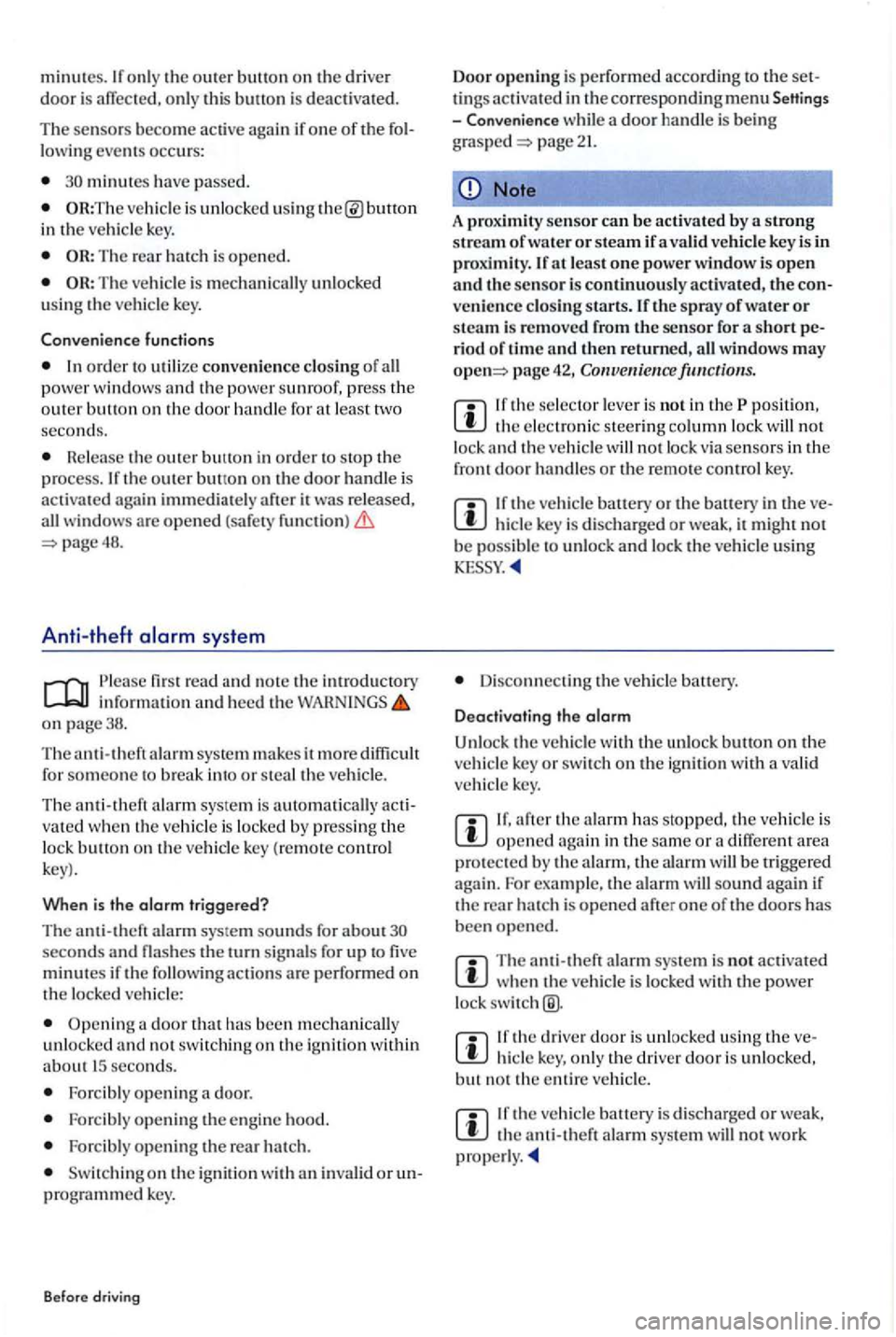
minutes. onl y the outer button on the driver door is affected, o nl y thi s button is deactivat ed.
The sensors become active again if one of the following events occurs:
minutes have pass ed.
OR:The vehicle is unlocked usin g button in the vehicle key.
order to uti lize convenience closing of all power window s and the power sunroof. press the outer button on the door handle for at least
the outer button in ord e r to stop the process.lfthe outer button on th e door handle is acti va te d a gain immedia te ly aft er it relea sed,
all windows are ope n ed (safe ty fun cti on) page 48.
Anti-theft system
lir st read and note the introduc tory information and heed the on page38.
The anti-theft alarm sys te m makes it more difficult
for someon e to break into or ste al the vehicl e.
The anti-theft alarm system is automati cally acti vated when th e ve hicle is locke d b y pressing the lock button on th e vehicle key (remote control
k ey).
When is the alarm trigg ered?
The anti-theft a larm system sounds fo r ab out seconds and fla shes the turn signals fo r up to minutes if the f ollowing a c ti ons are performed on the locke d vehicl e:
Opening been mechanic ally unlo cke d and not swit ching on the ig n ition w ithin about
Forcibl y opening a door.
Forcibl y opening the engin e hood.
Forcibl y opening the rear h atc h .
on the ig nit io n an invalid or unprogrammed key.
Before driving
Door opening is performed ac cording to the settings ac tivate d in the corresponding m enu Settings -Convenience a door handle is being
page
at least o ne power window is open and the sensor i s continuously activated, the convenience clos ing starts .
page
the ele c troni c ste e rin g column lock will not lo ck and the ve hi cle
hide ke y is discharged or it might not be possibl e to unlock and lo ck the vehicle using
D isconnecting the vehicle battery.
Deactivating the alarm
Unlock the ve hicl e with the unlock button on the vehicl e key or swit ch on the ignition with v alid vehicle key.
aft er the alarm h as stoppe d, the v ehi cle is opened aga in in the same or a differ ent area pro tecte d b y the alarm, the alarm sound again if the rear h a tc h is o pen ed after one of the doors has been o pe ned.
T he anti-theft alarm sys te m i s not activa te d w hen th e vehicle is locke d with the lock swit ch
th e driv er door is unloc ke d u sing the ve
the ve hicle battery is disc harge d or weak, not w ork properly.
Page 56 of 541
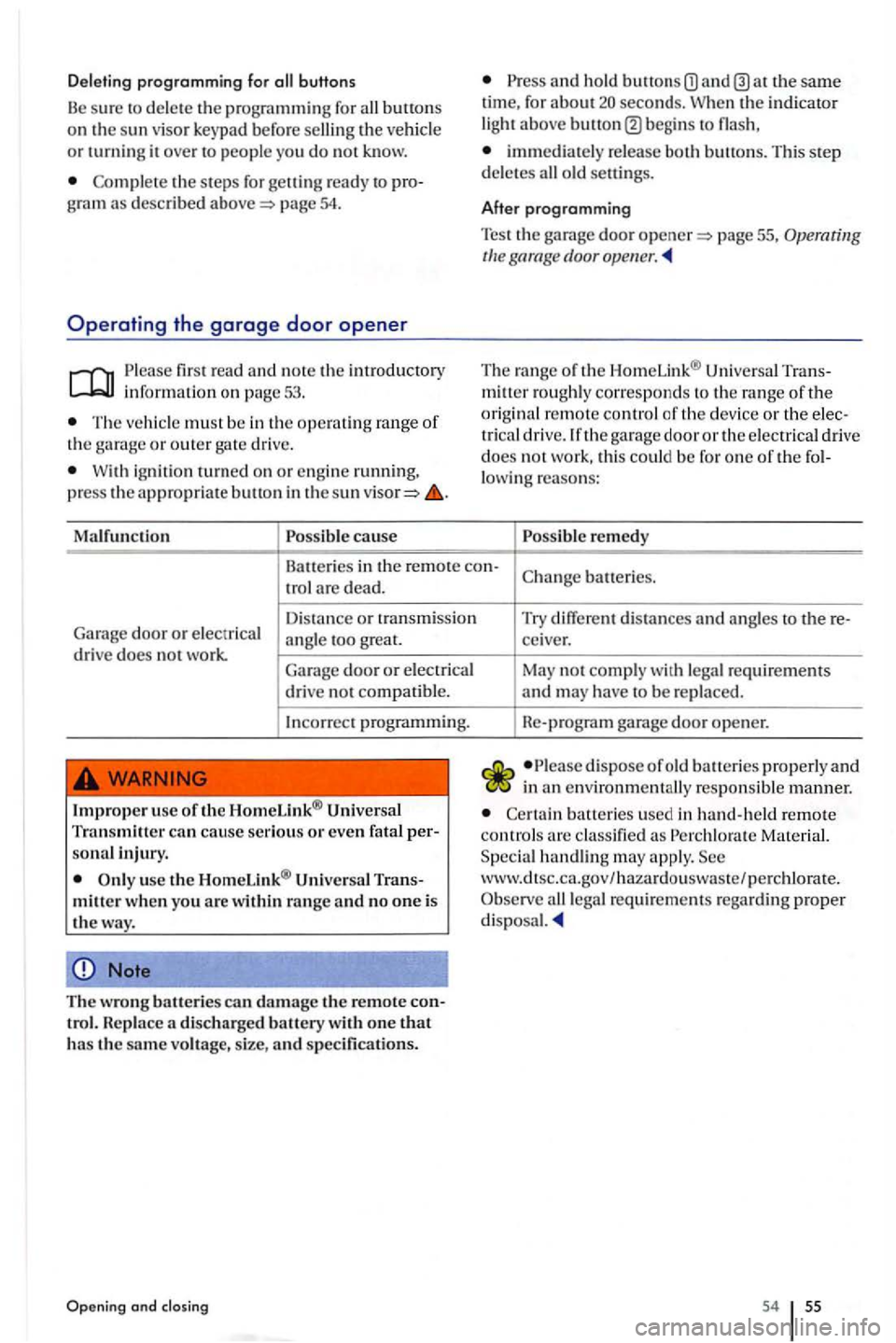
Deleting programming for
pro gramming for th e or turning it ove r to people you do not know.
the s te p s for getting ready to pro
gram as describ ed p age 5 4.
Operating the garage door opener
fir st re ad and note the introductory information on page 53.
The vehicl e must be in the operating range of th e garage or outer ga te drive.
W ith ig nit ion on or engin e running, press the appropriate button in th e sun
an d h old at the same tim e, for about seco nds. When the indicator
light abov e b egi ns to
immediately re lease both buttons. Thi s step dele tes
page 55, door
The rang e of th e 1-lomeLink® Trans
m itt er roughly
corresponds to th e range of the orig inal re mot e control of the device or th e e lec
tri ca l drive. Jfthe garage door or the e lec trical drive
does not work, this coul d be fo r o ne o f the fol
lo wing reasons:
re medy
Batteri es in th e remote con-batteries.
tr ol are dead.
Dis ta nce
or tr ansmission
G arag e door or e lectrica l
angl e too great.
dri ve does not work. Garage door or electrical
drive no t compatible.
In co rre ct programmin g.
usc th e HomcLink ® Trans
mi tter when you arc within range and no one is
th e way.
Note
The wro n g batteries can damage the remote control. Rep lace a discharge d battery wi th one that has th e sam e vo ltage , size , and specifications.
Opening and closin g
Try differe nt dista nces and angles to there-ce iver.
May not co mpl y with legal requirements and may have to be r e placed .
Re-program garage d
oor opener.
di spose of old batteries properly and in a n envir onmentally respon sibl e manner.
clas sified Material. S pec ial handling m ay apply. Se c wwlv.cltsc.ca .gov/ haza rdou swaste/perchlorate . lega l requir ements rega rdin g proper
54 5 5
Page 171 of 541
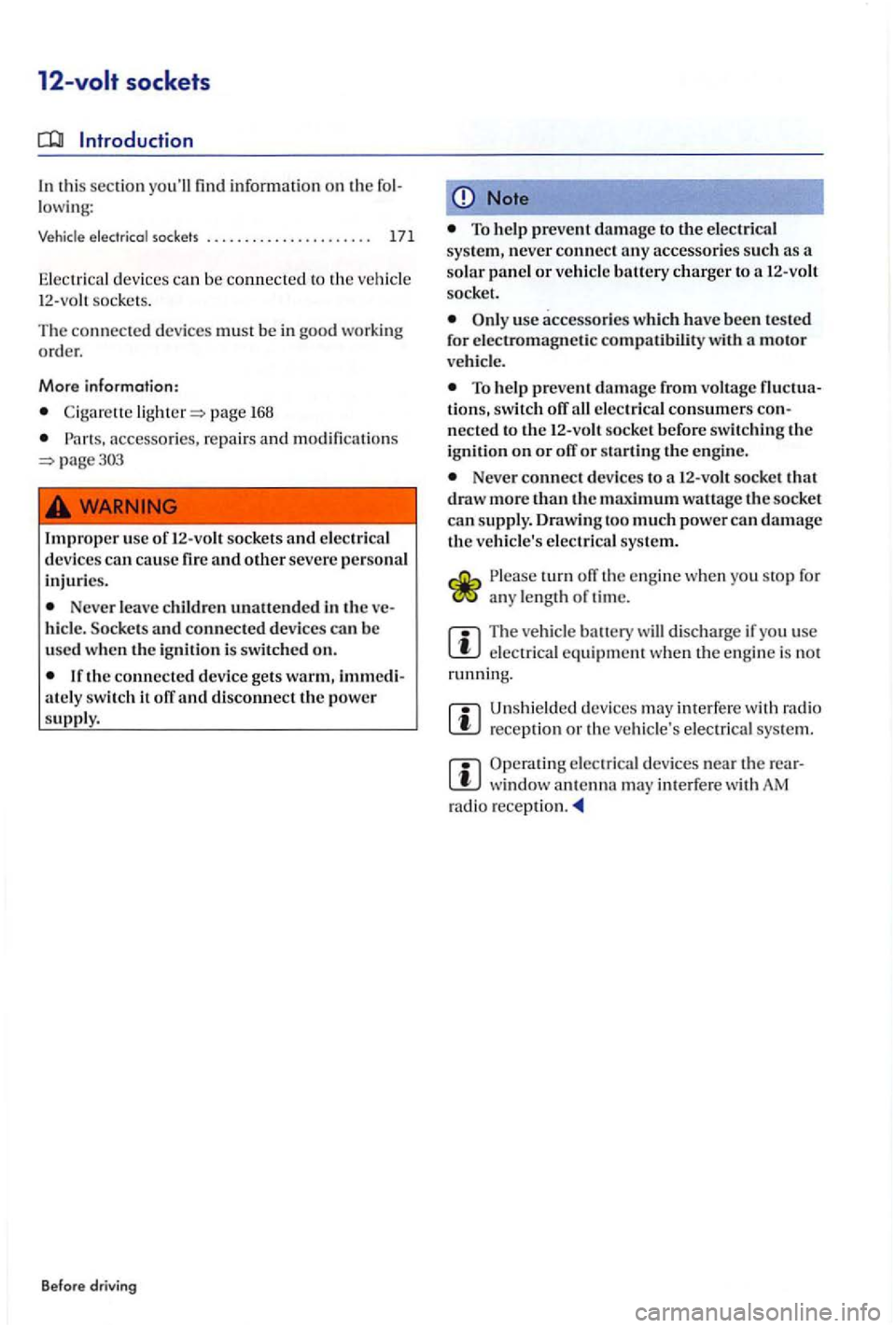
12-vol t sockets
In this section you'll find information on th e lowing:
Vehicle elec trica l sock ets . . . . . . . . . . . . . . . . . . . . . 171
Ele ctri ca l d evices can be connecte d to th e ve h icle
1 2 -volt sock ets .
Th e c
onnected device s must be in good worki ng
ord er.
More information:
page 168
accessorie s, re pairs and modification s page303
Improper u se of 12-vo lt soc kets and elec trica l
devi ces can cause fire a nd other severe pe rso nal
injuri es.
Never leave children unattende d in the hicle. Socke ts and con nected devices can be
used when the i gnitio n i s switched on.
ately switch it off and disconnect the pow er
s upply.
B efore driving
Note
To help prevent damage to the elec trical
sys tem, never connect any accessor ies su ch as a
so la r p anel
or veh icle battery charger to a 12-v olt
soc ket.
usc accessor ies whic h have bee n tested
for electromagne ti c compatibility with a motor vehicle.
To help prevent damage from voltage tions, switch off all electri cal consumers n ec ted to the 1 2-vo lt socke t be fore switchin g th e
i g nition on or off or startin g the engine .
Never connect dev ices to a 12-volt socke t that
draw mor e th an the maximum wa ttage the soc ke t can supply. Draw ing too much powe r ca n d amage the vehicle's elec trical sys te m.
turn off the engine when you stop fo r an y le n g th of tim e.
The vehicl e ba u ery will discharg e if you use elec trical equipm en t w hen the en gine is no t
running.
Uns hielded device s may interf ere with rad io reception o r th e v eh icle' s elec trica l sys tem.
Ope rating elec tr ica l devic e s near th e windo w an te n na ma y int erfere with AM
r adio re ception.
Page 172 of 541
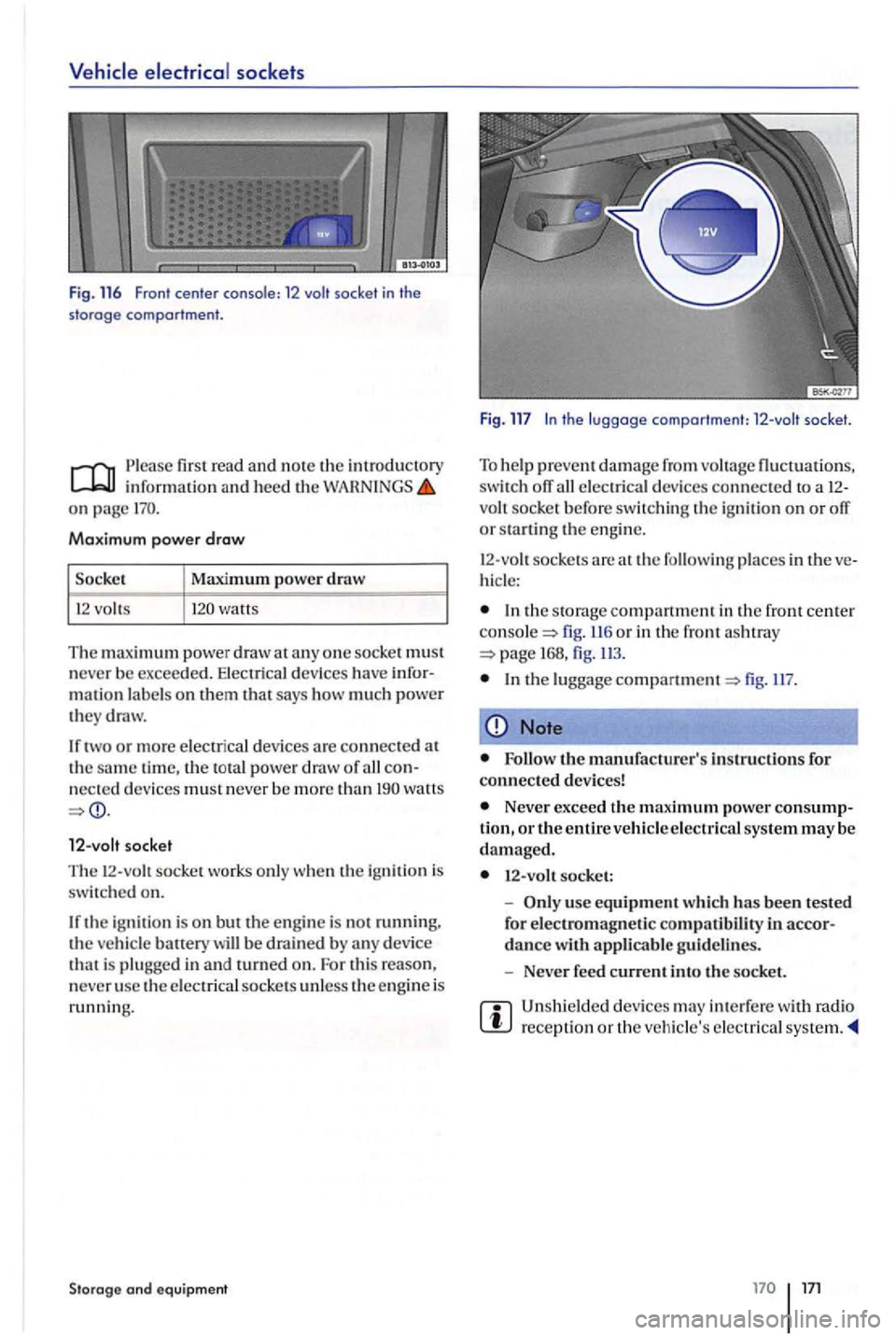
sock ets
F ig . 116 Fron t cente r conso le : 12 socket in the
sto rage comportment .
first r ea d and note the introductory information and heed the on page
Maximum power draw
watts
The maximum power draw at any one socke t must never be exceede d. Electrical devices have infor
m ation labels on them that says how muc h power they draw.
watts
socket
The socke t works only when the ig nition is swit ched on.
the ignition is on but the en g in e is not running. the ve hicl e battery will be drain ed by any device tha t is p lugged in and turned on. For this reason.
n ever use the e lectrical socke ts unl ess the engine is running.
Storage and eq uipment
Fig. 117 socket.
To h elp prevent damage from voltag e fluctuations,
swi tch off electric al devices connected to a 12-vo h socke t before swit ch ing the ignit ion on or
places in ve
hicl e:
the storage center fig . 116 or in the front ashtray 168, fig .
lugga ge fig.
Note
the manufacturer's instructions for
connected dev ic es!
Never exceed th e m aximum power consumption, or the entire ve hicl e electrical system may be damaged.
use equipment which has been tested for applicable gu ideli nes.
Neve r feed current into the socket .
Unshielded devices may interfere with radio reception or the veh icle's electrica l